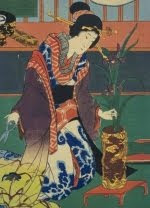For the arrangement today I've started with the task of using more than one vase. I bought these three vases this summer. They are made by my friend Brigitte Schneider of Atelier Tokibana in the South of France. The white and the blue vases are porcelain, while the black one is made of faience clay. The plant materials are autumn leaves with dark berries, Yarrow and Hydrangea.
As you can see it is still naturalistic freestyle, but more obvious than yesterday this arrangement uses lines and masses, and matching and contrasting colours to create a harmonious balance. The spaces between the vases and branches are also very important.
Using more than one vase. Naturalistic freestyle, Autumn leaves with dark berries, Yarrow and Hydrangea. Vases by Brigitte Schneider, Atelier Tokibana.
Today I've also been browsing the net for inspiration. I came across an interview in French with Marcia Shibata, who is a leading Kado teacher in Shambhala Buddhism and co-founder of Shambhala Kado Europe. Even though I have only met her once I still consider her a friend of mine.
In this interview she explains the meaning of the words Kado and Ikebana. Kado comes from an ancient Chinese term that is derived from two words. Ka is flower and do is path or way, dao in Chinese. It means "the path or the way of flowers", and indicates a journey; you start somewhere, you walk and you arrive somewhere. The term Ikebana, Ike-bana, exists only in Japanese. Ikeru means "to breathe" and as a consequence "being alive". Bana is a transformation of hana "flower". The Japanese like to combine things in a harmonious way, while ike-hana would sound too hard, ike-bana is more rounded at the same time hard and soft. It's like the ultimate desire for balance in life, as you try to have enough sharpness and enough softness or enough weight and enough lightness. So, Kado involves more the concept of a (spiritual) path to follow with flowers, while Ikebana puts more emphasis on the respect for the living nature and to give life or "breath" to the flowers. Both aspects are always present in flower practice, but to different degrees.
"The whole philosophy is that you don't try to be artistic, but you just approach objects as they are and the message comes through automatically. It is like Japanese flower arranging. You don't try to be artistic... it just seems to happen by itself." (Chögyam Trungpa, founder of Shambhala Buddhism and Sogetsu master)













4 comments:
Hei Lennart!
To be able to turn what's left on the trees into something so beautiful is truly a gift. A lot of what you write about is too technical for me, and I would have to read it thoroughly to get all the subtle meanings, which I don't have the energy for now. But I can still appreciate the beauty, and for that I thank you!
Thanks! This week I'm posting more philosophical and technical stuff than I usually do. Writing helps me sort things out in my own thoughts. Your absolutely right that it's not necessary to dive into these aspect to just enjoy and rest the eye for a moment.
I love the philosophical explanation! And of course the absolutely pleasing arrangements! The vases here are so lovely!! Please keep posting! Best wishes from all of us here at the Sogetsu Chennai Study Group!
I find that when I try to be smart, I fail. When I surrender, the work comes gracefully. This is true with my practice of Ikebana. Once I quiet my mind, I work intuitively and feel how the branches and flowers fit. My favorite arrangements are the nagiere, they come easier for me than working with a kenzan. What lovely vases. It is wonderful how the one horizontal branch visually connects all three arrangements. You truly brought in nature with this arrangement.
Post a Comment